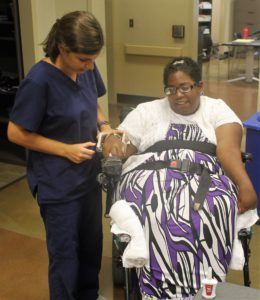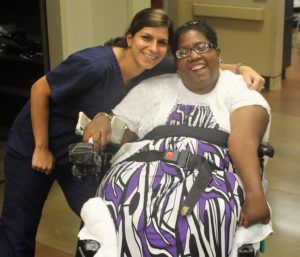How the Comfort of the Others Became my Passion
When I was in Occupational Therapy school, I was not particularly interested in seating and positioning for wheelchairs. However, it became personal to me  when I would a see an individual uncomfortable in his or her wheelchair, see mobility skills decrease due to positioning issues, or see how their seating system was not accommodating their hyper or hypo tonicity. Not knowing much about it, I began searching for knowledge- such as discussing this with the wheelchair vendors, questioning other therapists specialized in seating, and taking continuing education courses on seating/positioning and adaptive equipment as often as I could. After learning of the many aspects that affect positioning, and the varied wheelchair accessories/components that are on the market, I became even more intrigued. I figured this was one aspect of therapy that could provide immediate relief, whether I was fixing wheelchair brakes, adding foam in the back or seat cushions, or creating wheelchair accessories. For the adults I work with at LINCPoint, he or she is eligible to receive a new wheelchair every five or seven years depending on insurance, and obtaining a new part for a repair typically takes two to three months. I felt a responsibility to learn more about seating and positioning so I can make them as comfortable, functional, and safe with working components the best to my ability. For some of those on my caseload, wheelchair mobility is one of the only aspects they are independent in, and I wanted to preserve that as much as possible.
when I would a see an individual uncomfortable in his or her wheelchair, see mobility skills decrease due to positioning issues, or see how their seating system was not accommodating their hyper or hypo tonicity. Not knowing much about it, I began searching for knowledge- such as discussing this with the wheelchair vendors, questioning other therapists specialized in seating, and taking continuing education courses on seating/positioning and adaptive equipment as often as I could. After learning of the many aspects that affect positioning, and the varied wheelchair accessories/components that are on the market, I became even more intrigued. I figured this was one aspect of therapy that could provide immediate relief, whether I was fixing wheelchair brakes, adding foam in the back or seat cushions, or creating wheelchair accessories. For the adults I work with at LINCPoint, he or she is eligible to receive a new wheelchair every five or seven years depending on insurance, and obtaining a new part for a repair typically takes two to three months. I felt a responsibility to learn more about seating and positioning so I can make them as comfortable, functional, and safe with working components the best to my ability. For some of those on my caseload, wheelchair mobility is one of the only aspects they are independent in, and I wanted to preserve that as much as possible.
After doing some research, I decided to pursue an Assistive Technology Professional (ATP) certification through the Rehabilitation Engineering Society of North America (RESNA), which only eight other Occupational Therapists in Alabama had. According to RESNA, the ATP certification recognizes those who have reached an internationally accepted standard of knowledge in assistive technology with the highest ethical standards of practice. Also, for a wheelchair evaluation to take place, a wheelchair supplier and a therapist must be involved, and at least one of the two must have their ATP.  To apply for the examination, I had to establish eligibility through work and education, and then pass a four-hour exam covering various topics of assistive technology. I am very fortunate to have such a supportive boss who encouraged me all the way from the application process to passing the exam.
To apply for the examination, I had to establish eligibility through work and education, and then pass a four-hour exam covering various topics of assistive technology. I am very fortunate to have such a supportive boss who encouraged me all the way from the application process to passing the exam.
With this certification, I increased my knowledge in selecting appropriate seating and positioning systems, wheelchair accessories and components, and fabricating assistive technology to allow participation in an activity that the client otherwise wouldn’t be able to do. Such as creating a head-mounted art utensil so an individual can use head movement for coloring; fabricating joysticks that work individually for the person; or making small adjustments to a head array to improve access and maneuverability. For the participants on my caseload, I see them in their wheelchair throughout the day and during their daily activities and routines. With this certification, and as I gain more experience, my goal is to perform more in-house wheelchair evaluations at LINCpoint with my knowledge of their everyday activities to make their wheelchair evaluation as personable and holistic as p
